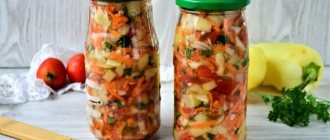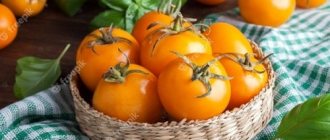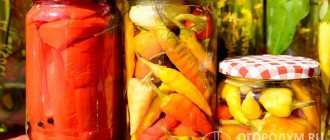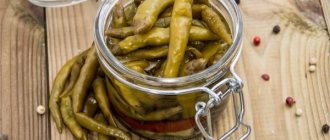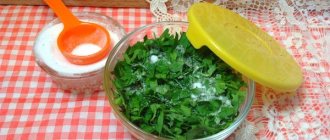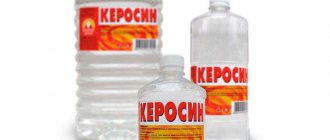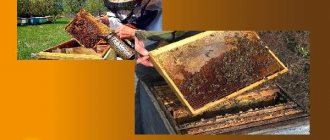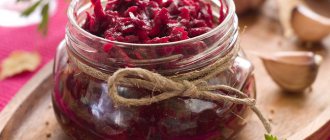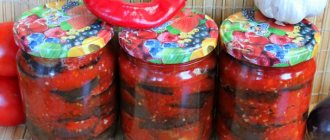Good day!
For lovers of vegetable caviar, the most wonderful recipes have been selected below. We will cook from squash. The preparation turns out to be very delicate in taste. There are many areas of its application. Can be added to soups and stews. But more often they are used as a cold appetizer for the main course. Or as a snack: spread it on bread and eat it. Appetizing and satisfying.
Squash tastes very similar to zucchini. Not surprisingly, they are the closest “brothers”. But the first ones have more delicate peel and seeds. Often they are simply enough to wash; you don’t even need to clean them. Of course, young vegetables are more tender and juicy. And they write on the Internet that it is from them that caviar should be prepared. You can, but then be prepared that its consistency will be very liquid. And in order to bring the mass to the desired consistency, it will have to be boiled longer. If there are no other options, then you should not pay attention to this nuance. But, if possible, take later fruits for caviar. This will not affect the taste, but the time saved will definitely come in handy.
Additions can be added to the main ingredient. Most often these are vegetables and flavorings. Take onions and carrots. Sometimes tomatoes and bell peppers. But mayonnaise or tomato paste is often added for taste. Or mix both ingredients.
We also remember that zucchini is the closest “relative” to squash. Therefore, you can safely mix them together, they go well together and differ little in taste. You definitely won't ruin anything.
Since this preservation undergoes heat treatment, it is almost never sterilized. For your own peace of mind, you can keep it in a preheated oven for a few minutes to kill off any possible bacteria that may have entered from outside. But most often, this is not necessary. The snack is perfectly stored in any conditions: either in a cool basement or in an apartment. And it is not advisable to store preserved food near heating sources. This is just a reminder.
Culinary secrets
Squash deserves the attention of a housewife who cares about the health of her loved ones. They contain substances that help strengthen vision, prevent premature aging of cells and the occurrence of cancer, reduce the risk of cardiovascular diseases, improve metabolism, strengthen the immune system, and relieve depression. A significant part of the benefits persists even after cooking the vegetable. Therefore, squash caviar is not only tasty, but also a healthy snack.
However, plate pumpkin, as squash is also called, is a specific vegetable. To obtain delicious caviar from this product, you need to know a few secrets.
- Squash has now become so popular that breeders are developing varieties of various shades. If you like to surprise guests and loved ones with unusual culinary masterpieces, try making an appetizer from colored squash. Using ordinary light-colored vegetables similar in color to zucchini, you will get caviar of a traditional color, reminiscent of zucchini.
- Ripe squash has very dense flesh, rough and thick skin, and large seeds. They must be cleaned before being used to obtain caviar. It will be easier to do this if you immerse the fruits in boiling water for 5 minutes, then bathe them in cold water. Pulp with large seeds also requires removal. Due to the laboriousness of preparing mature squash for canning, many people prefer to use only young vegetables, although they are more expensive. However, mature squash can also be used to prepare vegetable caviar.
- Young squash is not only tastier, but also healthier than old ones, so if you have the opportunity to choose, it is still better to give preference to them.
- Squash requires quite a long heat treatment, especially if they are mature, so caviar from them is usually made without sterilization. To soften vegetables, they are usually stewed, sometimes baked or fried. The choice of the nature of heat treatment depends on the specific recipe.
- It is more convenient to grind vegetables to a puree after heat treatment, when they become soft. To do this, they can be crushed with a blender. This method is the most convenient. You can also rub them through a sieve, but this will take a lot of time and effort. If you need to do without the help of kitchen appliances, but save energy, just simmer the squash longer, then stir the vegetables - they themselves will turn into a mass that has the consistency of vegetable caviar.
- It is convenient to mix the chopped vegetables with a whisk. You can also beat them with a mixer.
- When boiling, vegetable caviar gurgles and “shoots.” To avoid getting burned, cover the pan with a lid. To stir the vegetable mass, lift the lid without removing it completely. To stir the dish, use a ladle, spoon or spatula with a long handle.
- Sterilization of jars and lids is an operation that cannot be skipped when preparing vegetable caviar for the winter. How you sterilize the container does not matter.
- Jars of caviar can be closed with metal lids that can be rolled with a key or with screws. But polyethylene lids are not suitable for this.
Patisson caviar is not a capricious preparation. These canned foods do not spoil even when stored in a heated room. Therefore, they can be kept not only in the cellar or basement, but also in the apartment (in the kitchen or pantry). However, in a cool place, caviar from squash will stand better and retain good organoleptic qualities not for a year, but for two or three.
What are the benefits of a vegetable?
Patisson (or plate pumpkin) is low in calories. The vegetable contains many different micronutrients, including:
- Potassium and magnesium. Microelements prevent the occurrence of pathologies of the heart and blood vessels.
- Lutein, carotene, zeaxanthin. Prevent the development of cancerous tumors, improve vision.
- Vitamins B2 and B6. The first has a positive effect on the body during migraines, the second increases concentration, eliminates the feeling of fatigue, and suppresses depression.
- Vitamin C. Strengthens the immune system.
Squash and vegetable products are not recommended to be consumed if pathologies of the gastrointestinal tract or diabetes mellitus are detected.
Classic recipe for squash caviar “You'll lick your fingers”
What you need (for 3 l):
- squash - 1.5 kg;
- carrots – 0.5 kg;
- onion – 0.5 kg;
- tomatoes – 1.5 kg;
- garlic – 1 head;
- sugar – 15-20 g;
- salt – 15-20 g;
- table vinegar (9 percent) – 60 ml;
- refined vegetable oil – 0.2 l;
- capsicum (optional) - to taste.
How to cook:
- Sterilize 0.5-1 liter jars by holding over steam or in the oven for 15-20 minutes. Let them cool a little and dry.
- Boil the lids. If they have a rubber seal, it is better to remove it while boiling and then return it to its place.
- Wash the vegetables. Peel the onions and carrots. If the squash is large, they also need to be cleaned by first boiling them for 5 minutes and cooling.
- Cut the squash into slices, remove the pulp and seeds.
- Cut the carrots into medium pieces.
- Chop the onion as finely as possible.
- Grind carrots, tomatoes, squash and garlic separately through a meat grinder. Important: Do not mix the vegetables at this stage.
- Heat the oil in a saucepan with a good non-stick coating or in a cauldron, put the onions and carrots in it. After 10 minutes, add the squash to them. Simmer the vegetables over low heat for half an hour, then add the tomato puree. Continue to simmer the vegetables for the same amount of time.
- If you want the caviar to have the most delicate consistency, rub it through a sieve. If you are happy with the crumbly texture, move on to the next cooking step.
- Add sugar, salt, garlic and pepper. Simmer the caviar for 5 minutes.
- Pour in vinegar, stir, remove from heat.
- Place the caviar in previously prepared jars and roll up the container.
Delicate squash caviar made according to the given recipe will appeal to both adults and children.
Tip: when cooking for children, do not add pepper to the appetizer.
Ingredients:
| Patisons | – 1.5 kg. |
| Carrot | – 300 gr. |
| Tomatoes | – 400 gr. |
| Onion | - 3 pcs. |
| Garlic | – 3 cloves |
| Vegetable oil | – 30 gr. |
| Spices | - taste |
To prepare the most delicate caviar, you first need to prepare the vegetables.
Step 1
Peel the carrots and grate them on a coarse grater.
Step 2
Peel the onion and cut into thin slices.
Step 3
Peel the garlic and finely chop it (if desired, it can be crushed using a garlic press).
Step 4
Place all the ingredients in the multicooker bowl, add a little oil and turn on the “Fry” mode. Fry the ingredients until light golden brown.
After browning, add pre-cut tomato and a little water to the bowl - it should cover the vegetables halfway.
Step 5
Cook the ingredients until tender - they should become soft. Then add sugar, salt and spices to the multicooker bowl; mix the products thoroughly.
Step 6
Transfer the resulting mass to a blender and thoroughly beat the mixture until pureed. There should be no lumps in it.
Bring the mixture to a boil in a multicooker on the “Stew” program.
Step 7
While the squash appetizer is boiling, prepare the jars: rinse them thoroughly and sterilize them over steam.
We transfer the finished caviar into jars and close the lids. It is important to do this while the mixture is hot.
That's all - squash caviar for the winter, cooked in a slow cooker, is ready. All you have to do is wait until it cools down and then transfer the jars to the refrigerator.
It is recommended to open the workpiece 2 months after twisting - this way it can be completely soaked and become even tastier and healthier.
Watch another version of this dish in the video below:
Squash caviar with tomato paste
What you need (for 3 l):
- squash - 4 kg;
- carrots – 0.5 kg;
- onion – 0.25 kg;
- garlic – 1 head;
- table vinegar (9 percent) – 100 ml;
- tomato paste – 100 g;
- sugar – 20 g;
- refined vegetable oil – 150 ml;
- water – 150 ml;
- salt, pepper - to taste.
How to cook:
- Peel the squash, cut in half, and scoop out the seeds with a spoon. Cut the pulp, cleared of all excess, into cubes about 1 cm in size.
- Peel the carrots and cut into small cubes or strips.
- Cut the onion into small pieces.
- Heat the oil in a cauldron or deep frying pan. The volume of the dish must be sufficient to accommodate onions, carrots and squash, otherwise the vegetables will have to be fried in parts.
- First add the onion to the oil, after a couple of minutes add the carrots, after 7-8 minutes add the squash. After 10 minutes, transfer the vegetables from the frying pan to the pan in which further cooking will take place.
- Pour water into the pan. Simmer its contents for half an hour.
- While the vegetables are stewing, you have the opportunity to sterilize the jars, do not miss it.
- Add finely chopped garlic and tomato paste, stir. Boil the vegetables for 5 minutes.
- Blend the contents of the pan with an immersion blender. You can chop the vegetables in a blender glass, but then you will have to add them in small portions.
- Add sugar and salt to the vegetable puree and season to taste. Pour in vinegar and stir.
- Bring the squash caviar to a boil and place in the prepared container.
- Turn the jars of caviar over and cover with a blanket. Let them cool in a steam bath. This is a kind of sterilization that increases the resistance of canned food to unfavorable storage conditions.
After cooling, the jars of squash caviar can be taken to the basement, pantry or other room where you usually store supplies for the winter.
Cooking features
- Squash, also called plate pumpkin, is grown today in a variety of colors. Any type of squash is suitable for preparing vegetable caviar. Using vegetables in bright colors, you will make an unusual snack. Regular light squash will produce caviar of a traditional color.
- To prepare a snack, it is advisable to choose young fruits. You just need to wash them, dry them and chop them, following the instructions in the recipe. Ripe vegetables should be peeled and seeds removed. The peel will be easier to peel if you boil the fruits for a few minutes, then cool in cold water.
- To give the appetizer the consistency of caviar, squash and other vegetables are rubbed through a sieve, turned through a meat grinder or crushed in a blender. Raw vegetables are less susceptible to such chopping than those that have already undergone heat treatment. Therefore, squash and other snack components are often boiled, stewed, fried or baked until softened before chopping.
- Jars for caviar must be washed with soda and sterilized, otherwise the canned food will not last long. The method of sterilizing the jars does not matter. This procedure can only be abandoned if the jars are sterilized later along with the snack, but this technology is considered labor-intensive and is rarely chosen.
- Cover the workpiece with metal lids to ensure tightness. Plastic ones will not cope with this purpose. Lids must be sterilized before use. They are usually boiled for this purpose.
- Squash does not have pronounced organoleptic qualities, so caviar from them is almost always prepared with tomatoes or tomato paste. To improve the taste of the finished dish, it also often includes onions, carrots and some other vegetables, as well as spices and herbs.
You can store caviar made from squash at room temperature, although canned food always costs better in a cool place. The minimum shelf life of the product is a year, but usually it does not deteriorate for two or even three years.
Do squash taste different from zucchini?
Yes
80.33%
No
19.67%
Voted: 61
Provençal squash caviar with mayonnaise and mustard
What you need (for 3 l):
- squash – 3 kg;
- garlic – 5-6 cloves;
- vegetable oil – 120 ml;
- tomato paste – 100 ml;
- mayonnaise – 100 ml;
- table mustard – 10 ml;
- water – 0.3 l;
- table vinegar (9 percent) – 30 ml;
- sugar – 60 g;
- salt – 30 g;
- ground paprika – 3 g;
- hops-suneli – 3 g;
- ground black pepper – 3 g.
How to cook:
- Cut the squash, peeled and seeded, into medium cubes, place in a saucepan, add water, simmer until soft, then puree in a blender.
- Place mayonnaise, mustard, tomato paste and pressed garlic into a container with squash puree. Add spices, salt, sugar. Mix the ingredients. As a result, the mass should become homogeneous and monochromatic.
- Cover the pan with a lid and boil the squash caviar for 15 minutes.
- Pour in vinegar and stir. Continue simmering the appetizer for 5 minutes.
- Distribute the delicate caviar into sterilized jars, seal them tightly, turn them over and cool in a steam bath.
Don't be confused by the presence of mayonnaise in this dish. There is not enough of it to make the snack unhealthy and high in calories.
Caviar according to this recipe is low-calorie, because it does not even contain vegetable oil.
Spicy squash caviar with bell pepper
What you need (for 3 l):
- squash – 3 kg;
- tomatoes – 1 kg;
- carrots, onions, bell peppers – 0.5 kg each;
- garlic – 2 cloves;
- hot capsicum – 1 pc.;
- sugar – 45 g;
- salt – 30 g;
- refined sunflower oil – 180 ml;
- apple cider vinegar (6 percent) – 40 ml;
- dill, parsley, ground black pepper - to taste.
How to cook:
- Wash the vegetables, dry them, cut into strips.
- Separately fry the onions, carrots, squash and bell peppers.
- Grind the fried vegetables, as well as tomato slices, garlic cloves, pieces of hot pepper and herbs through a meat grinder or chop using a blender.
- Stir the vegetables. Simmer them for 10-30 minutes until the caviar seems thick enough.
- Add salt, pepper, sugar, vinegar. Stir. Simmer for another 5 minutes.
- Place squash caviar in pre-sterilized jars. After rolling up the containers, turn them over and wrap them up.
The next day, the jars of caviar can be returned to their normal position and transported to a place of permanent storage. This is usually a storage room or basement.
The benefits of the workpiece
Caviar in a slow cooker made from squash for the winter is not only tasty, but also very healthy:
- Fresh vegetables saturate the body in winter with vitamins and other elements that are important for it to maintain normal performance.
- Carrots, squash and tomatoes help fight many diseases and disorders of the body.
- Squash caviar, made in a slow cooker, will provide you with a boost of strength and vigor for the whole day.
- The vitamins accumulated in the preparation will protect you from viral diseases, of which there are quite a lot in the winter.
It is also worth noting that squash caviar is stored for a long time, so you can pamper your household with the most delicate and appetizing preparation throughout the winter.
Spiced squash caviar
What you need (for 3 l):
- squash – 3 kg;
- tomatoes – 1 kg;
- carrots – 0.5 kg;
- onion – 0.5 kg;
- sugar – 120 g;
- salt – 30 g;
- curry seasoning – 6 g;
- Provençal herbs – 15 g;
- table vinegar (9 percent) – 60 ml;
- vegetable oil (refined) – 120 ml.
How to cook:
- Grate the carrots and squash, finely chop the onion.
- Cut the tomatoes in half, grate, and at the same time separate the pulp from the skin.
- Pour oil into a cauldron or thick-walled pan, add grated vegetables, including tomatoes, and finely chopped onions.
- Simmer the vegetables for half an hour. During this time, prepare the container.
- Add salt, sugar, curry and Provençal herbs to the vegetable mixture. After stirring the vegetable mixture, simmer for 5 minutes. Add vinegar, simmer the same amount.
- Distribute the snack among the prepared containers. Leave the jars of caviar upside down under a blanket, blanket or other warm item to cool.
The caviar according to this recipe is very aromatic. It will also be tender if you beat it with a blender or rub it through a sieve before adding spices, but then it will take much more time to prepare the canned food.
LiveInternetLiveInternet
—Quote book
I offer you a recipe for a snack for the holiday table. It is prepared very simply and quickly. Cro.
An Easter woman's crumb is similar to a muffin's - it is moister, with a different texture and structure.
Well, let's go over the sweet stuff, shall we? Try making this pumpkin cream pie.
Today I have a new salad recipe for you. It’s perfect for a holiday menu - .
Chicken wings in Coca-Cola (Kale Ji Chi) are a relatively new blue.
—Tags
—Search by diary
—Subscription by e-mail
-Statistics
Patisson caviar with aromatic roots
What you need: (for 2-2.5 l):
- squash – 0.2 kg;
- tomatoes – 0.5 kg;
- carrots – 0.3 kg;
- onion – 0.3 kg;
- celery root – 50 g;
- parsley root – 25 g;
- parsley – 30 g;
- salt, sugar – 10-20 g each;
- vegetable oil – 120 ml;
- garlic - to taste;
- table vinegar (9 percent) – 60 ml.
How to cook:
- Fry finely chopped onion and coarsely grated carrots until soft.
- Brown the sliced squash separately.
- Grind the fried vegetables using a meat grinder or blender.
- Using a blender, meat grinder or grater, turn parsley roots, celery and garlic into a gentle puree.
- Blend the tomatoes with a blender.
- Combine tomato puree with chopped squash, carrots and onions. Add roots, oil and salt to them.
- Boil the vegetable mixture to the desired thickness.
- Add vinegar, boil the caviar with it for 2-3 minutes.
- Fill pre-sterilized jars with caviar. Place them bottom down and cool in a steam bath.
There are no hot or spicy seasonings in this snack, but the roots make it no less aromatic than caviar cooked with spices.
Baked squash caviar
What you need (for 1.5 l):
- squash - 1.5 kg;
- onion – 0.3 kg;
- tomato paste – 0.2 l;
- refined oil – 60 ml;
- cloves - 1 umbrella;
- allspice – 2 pcs.;
- salt, sugar - to taste;
- vinegar essence (70 percent) – 5 ml.
How to cook:
- Cut the squash, peeled and seeded, into slices, place on a greased baking sheet and bake for 20 minutes in an oven preheated to 180 degrees.
- Fry the onion, finely chopped, in the remaining oil.
- Puree the baked squash using a blender or other convenient method.
- Mix squash puree with fried onions and tomato paste. Add salt and sweeten.
- Grind the spices in a mortar or grind them using a special mill, add to the vegetables.
- Simmer the vegetable puree for a quarter of an hour, pour vinegar into it and boil for another 5 minutes.
- Fill the container prepared in advance with vegetable caviar.
- Close the jars tightly and place the lids down. Place a blanket over the jars and leave them until the morning.
The taste of caviar from baked squash is exquisite and rich. No gourmet will refuse such a snack.
Caviar from zucchini and squash
What you need (for 3 l):
- zucchini and squash - 2 kg each;
- onions, carrots, bell peppers – 0.5 kg each;
- tomato paste – 100 g;
- water – 0.2 l;
- sugar – 40 g;
- salt – 20 g;
- apple cider vinegar (6 percent) – 60 ml;
- sunflower oil – 0.2 l.
How to cook:
- Cut the vegetables into strips and fry separately in vegetable oil.
- Chop the fried vegetables in any way convenient for you, put them in a saucepan.
- Add tomato paste diluted with water.
- Simmer until there is no excess liquid left in the vegetable mass. This will take about an hour.
- Add remaining ingredients. Simmer the squash-squash caviar for 10 minutes after it starts to gurgle.
- Place the snack in sterilized jars. Seal the container hermetically and leave it under the blanket until the morning. The jars must be turned over before covering them with a blanket.
Zucchini and squash go well together. The vegetable caviar they make is incomparable, you'll just lick your fingers!
Which pitissons to choose
To make squash preparations tasty, you must adhere to the following rules:
- It is advisable to use young fruits for canning; small squash can be pickled whole;
- if there are only large fruits, 7-8 cm in diameter, then they are best used for making caviar or salads;
- The taste of squash is similar to zucchini, so they can be preserved using the same recipes. But squash must be blanched before cooking;
- Before cooking, wash the squash thoroughly and cut off the stem. There is no need to peel the peel, it is very thin;
- You can preserve squash along with other vegetables; they go well with onions, carrots, tomatoes, cabbage, zucchini, etc.
Interesting facts: squash is an artificially bred variety of pumpkin; this plant is not found in the wild. The vegetable got its name from its unusual shape; the name comes from the French word for “pie.”
